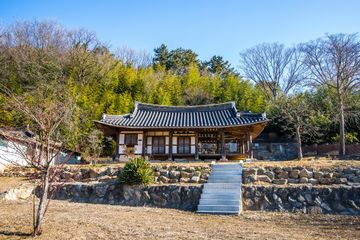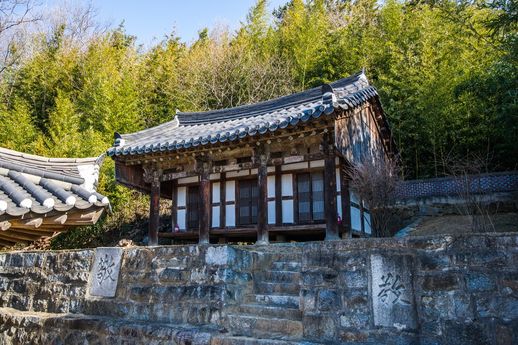정읍 영주정사와 영양사
| 정읍 영주정사와 영양사 Yeongjujeongsa Lecture Hall and Yeongyangsa Shrine, Jeongeup |
|
 엽토51, "정읍 영주정사(瀛洲精舍)와 영양사(瀛陽祠)_근대기 건축", 쏠쏠한 일상, 네이버 블로그. |
|
| 대표명칭 | 정읍 영주정사와 영양사 |
|---|---|
| 영문명칭 | Yeongjujeongsa Lecture Hall and Yeongyangsa Shrine, Jeongeup |
| 한자 | 井邑 瀛州精舍와 瀛陽祠 |
| 주소 | 전라북도 정읍시 현암2길 40 |
| 지정(등록) 종목 | 국가등록문화재 제212호 |
| 지정(등록)일 | 2005년 11월 11일 |
| 분류 | 등록문화재/기타/교육시설/ |
| 시대 | 대한제국시대 |
| 수량/면적 | 2동, 1층 연면적 영주정사 64.8㎡ 영양사 20.8㎡ |
| 웹사이트 | "정읍 영주정사와 영양사", 국가문화유산포털, 문화재청. |
|
|
|
해설문
국문
정읍 영주정사와 영양사는 조선 후기 정읍 출신 유학자 박만환(1849~1926)이 지었다. 영주정사는 강당에 주거형 평면을 도입하여 난방의 효율성과 공간이용의 합리성을 꾀하였으며, 근대기 한옥의 특징을 잘 보여주고 있어 건축사적, 역사적 가치가 크다. 박만환은 지주였지만 동학농민혁명에 자금을 지원하고 내장산에서 열린 호남유림대회에 참여하였으며, 국권을 회복하기 위해 학교를 세우는 등 항일운동에도 앞장섰다고 전한다.
영문
Yeongjujeongsa Lecture Hall and Yeongyangsa Shrine were built by Park Man-hwan (1849-1926) in 1903 and 1909, respectively.
Park Man-hwan was a Confucian scholar born in Jeongeup. He financially supported the Donghak Peasant Revolution of 1894 and participated in independence movements during the Japanese colonial period (1910-1945).
The lecture hall consists of a wooden-floored hall, two underfloor-heated rooms, two storage rooms, a closet, and a kitchen. Compared to traditional lecture hall buildings, which have a wooden-floored hall at the center and an underfloor-heated room on either side, this building has the hall to the right and both rooms to the left, which is a result of 20th-century architectural influence.
The shrine houses spirit tablets and portraits of Confucian sages. The Chinese character "gyeong (敬)" carved to either side of the stone stairway means "to pay respect."
영문 해설 내용
영주정사와 영양사는 박만환(1849-1926)이 각각 1903년과 1909년에 지었다.
박만환은 정읍 출신의 유학자로 동학농민혁명에 자금을 지원했고 항일운동에도 앞장섰다.
영주정사는 대청, 방 2개, 창고 2개, 반침 1개, 부엌 1개로 구성되어 있다. 전통적인 강당 건물은 가운데 대청을 중심으로 양 옆에 방이 배치되는데, 영주정사의 구조는 20세기에 건축된 한옥의 변화를 보여주는 것이다.
영양사에는 중국 성현의 영정을 봉안했다. 석축에 새겨진 “경(敬)”이라는 글자는 “공경하다”라는 뜻이다.
갤러리
영양사[1]
참고
- 『정읍 영주정사 및 영양사 기록화 조사보고서』, 문화재청, 2013.
주석
- ↑ 엽토51, "정읍 영주정사(瀛洲精舍)와 영양사(瀛陽祠)_근대기 건축", 쏠쏠한 일상, 네이버 블로그.
